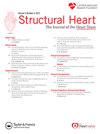经导管主动脉瓣置换术治疗先天性主动脉反流:准备好了吗?
IF 2.8
Q3 CARDIAC & CARDIOVASCULAR SYSTEMS
引用次数: 0
摘要
未经治疗的临床上明显的主动脉瓣反流(AR)在一般人群中很常见,并且与较差的结果相关,包括较高的死亡率。手术主动脉瓣置换术是目前严重AR的治疗选择。然而,由于高龄、虚弱和潜在的合并症,这些患者中有很大一部分不是很好的手术候选人,这促使了对经导管选择的需求。目前的指南不推荐经导管主动脉瓣置换术(TAVR)治疗严重的AR,并使用市售的经导管心脏瓣膜(thv)。商业化TAVR装置的说明书外使用与手术成功率较低、并发症增加(主要是瓣膜栓塞和残余AR)以及临床结果较差相关。当前一代thv的TAVR效果不佳归因于解剖因素,如缺乏环钙,主动脉环大,主动脉根部扩张,给装置锚定带来挑战。带有专用AR设备(如JenaValve和J-Valve)的TAVR正在迅速发展,初步证据表明,在短期随访期间,手术成功率更高,临床结果也有所改善。对于严重AR的专用thv经导管治疗的开发,有很大的未满足需求,JenaValve和J-Valve系统在美国监管部门批准之前都在进行严格的临床试验测试。本文章由计算机程序翻译,如有差异,请以英文原文为准。
Transcatheter Aortic Valve Replacement for Treating Native Aortic Regurgitation: Ready for Prime Time?
Untreated clinically significant aortic regurgitation (AR) is frequently seen in the general population and is associated with worse outcomes, including higher mortality. Surgical aortic valve replacement is currently the treatment of choice for severe AR. However, a significant proportion of these patients are not good surgical candidates due to advanced age, frailty, and underlying comorbidities, prompting the need for transcatheter options. Current guidelines do not recommend transcatheter aortic valve replacement (TAVR) for severe AR with commercially available transcatheter heart valves (THVs). Off-label use of commercial TAVR devices has been associated with lower procedural success, increased complications, mainly valve embolization and residual AR, and poor clinical outcomes. The suboptimal results of TAVR with the current generation THVs are attributed to anatomical factors such as a lack of annular calcium, a large aortic annulus, and a dilated aortic root, posing challenges for device anchoring. TAVR with dedicated devices for AR, such as the JenaValve and the J-Valve, is rapidly evolving, with preliminary evidence suggesting higher procedural success rates and improved clinical outcomes during short-term follow-up. There is a significant unmet need for the development of transcatheter therapies with dedicated THVs for severe AR, and both the JenaValve and J-Valve systems are undergoing rigorous clinical trial testing before regulatory approval in the United States.
求助全文
通过发布文献求助,成功后即可免费获取论文全文。
去求助
来源期刊

Structural Heart
Medicine-Cardiology and Cardiovascular Medicine
CiteScore
1.60
自引率
0.00%
发文量
81
 求助内容:
求助内容: 应助结果提醒方式:
应助结果提醒方式:


